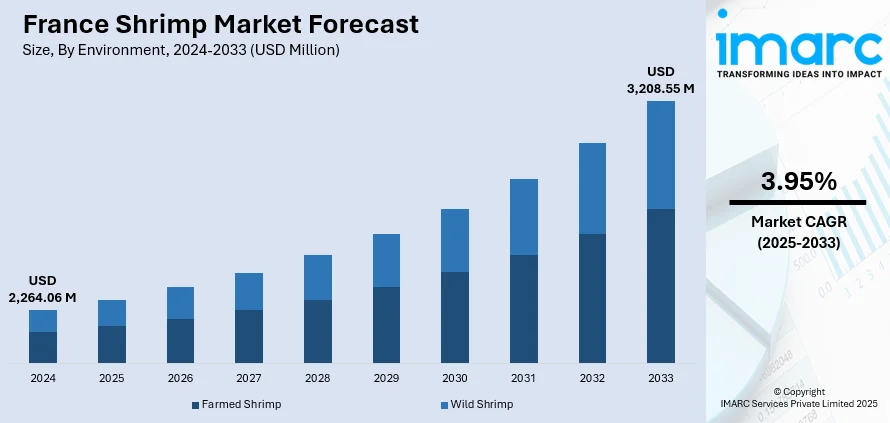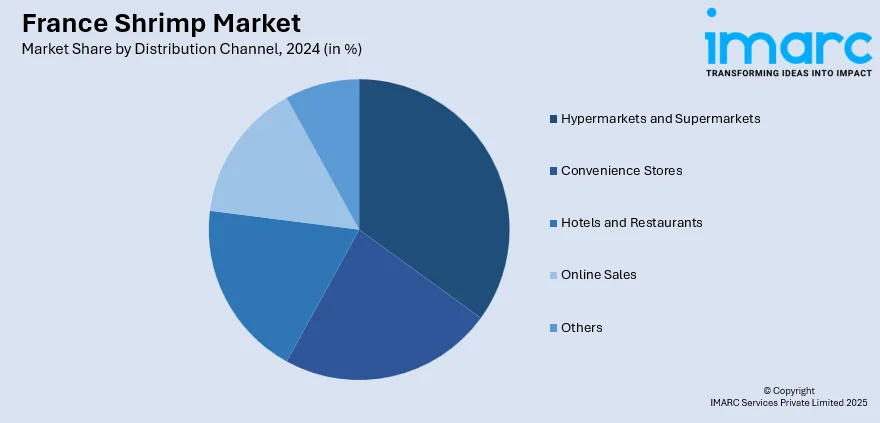
France Shrimp Market Size, Share, Trends and Forecast by Environment, Species, Shrimp Size, Distribution Channel, and Region, 2025-2033
France Shrimp Market Overview:
The France shrimp market size reached USD 2,264.06 Million in 2024. The market is projected to reach USD 3,208.55 Million by 2033, exhibiting a growth rate (CAGR) of 3.95% during 2025-2033. The market is expanding as local farms use modern systems and clean water methods to meet growing demand for fresh, traceable seafood. Furthermore, ongoing farm upgrades and better supply links continue to support France shrimp market share across retail, restaurant, and regional food service channels.
|
Report Attribute
|
Key Statistics
|
|---|---|
|
Base Year
|
2024 |
|
Forecast Years
|
2025-2033
|
|
Historical Years
|
2019-2024
|
| Market Size in 2024 | USD 2,264.06 Million |
| Market Forecast in 2033 | USD 3,208.55 Million |
| Market Growth Rate 2025-2033 | 3.95% |
France Shrimp Market Trends:
Local Supply Meets Fresh Demand
France shrimp market growth is seeing a steady rise as buyers look for home-farmed seafood that is fresh and trustworthy. Consumers want shrimp with clear sourcing and fewer chemicals, pushing small producers to build local farms with modern systems. Some farms have started using recirculating water setups that cut waste and keep shrimp healthy year-round. A few coastal regions have supported these small farms with grants to build new hatcheries and cold storage, helping farmers reach city shops faster. Supermarkets are testing fresh counters for local shrimp to offer shoppers an alternative to imports. Chefs in urban areas now feature regional shrimp on menus, giving restaurants an edge with quality and traceability. Small-scale farmers benefit from shorter supply routes and stronger prices when selling direct to restaurants and local stores. Some producers are even packaging ready-to-cook shrimp to attract busy households. Regional seafood fairs are helping farmers meet new buyers and sign supply deals for steady sales. These steps together reduce the gap between farms and end buyers, keeping more value in local communities. Clear labelling and honest marketing also help small farms stand out, building trust and giving France’s shrimp market a good base for steady expansion.

To get more information on this market, Request Sample
Better Systems and Clean Practices
France’s shrimp farms are improving how they operate to meet stricter standards and compete with imports. Some producers have switched to indoor tank systems with water treatment units to keep conditions stable and disease low. Others now use renewable energy like solar panels to power pumps and reduce electricity costs. A few farms have added smart feeding tools that adjust feed amounts automatically, cutting waste and saving money. Research projects have supported trials with new feed blends using local ingredients to rely less on imported fishmeal. In western France, one farmer group opened a shared processing unit this year to help small growers clean, pack, and chill shrimp before delivery, cutting costs and boosting freshness. Local councils encourage farms to reuse water and control waste to protect nearby rivers. Seafood suppliers have started promoting these green steps in export markets, hoping to sell premium French shrimp abroad. Some delivery firms now offer fast chilled transport, helping small producers supply shops and restaurants without using frozen storage. Together, these upgrades help farms raise output while staying in line with tighter rules. All these efforts give France’s shrimp market a better chance to hold its share and win over buyers looking for responsible seafood.
France Shrimp Market Segmentation:
IMARC Group provides an analysis of the key trends in each segment of the market, along with forecasts at the country and regional level for 2025-2033. Our report has categorized the market based on environment, species, shrimp size, and distribution channel.
Environment Insights:
- Farmed Shrimp
- Wild Shrimp
The report has provided a detailed breakup and analysis of the market based on the environment. This includes farmed shrimp and wild shrimp.
Species Insights:
- Penaeus Vannamei
- Penaeus Monodon
- Macrobrachium Rosenbergii
- Others
The report has provided a detailed breakup and analysis of the market based on the species. This includes penaeus vannamei, penaeus monodon, macrobrachium rosenbergii, and others.
Shrimp Size Insights:
- <21
- 21-25
- 26-30
- 31-40
- 41-50
- 51-60
- 61-70
- >70
The report has provided a detailed breakup and analysis of the market based on the shrimp size. This includes <21, 21-25, 26-30, 31-40, 41-50, 51-60, 61-70, and >70.
Distribution Channel Insights:

- Hypermarkets and Supermarkets
- Convenience Stores
- Hotels and Restaurants
- Online Sales
- Others
A detailed breakup and analysis of the market based on the distribution channel have also been provided in the report. This includes hypermarkets and supermarkets, convenience stores, hotels and restaurants, online sales, and others.
Regional Insights:
- Paris Region
- Auvergne-Rhône-Alpes
- Nouvelle-Aquitaine
- Hauts-de-France
- Occitanie
- Provence Alpes Côte d’Azur
- Grand Est
- Others
The report has also provided a comprehensive analysis of all the major regional markets, which include Paris Region, Auvergne-Rhône-Alpes, Nouvelle-Aquitaine, Hauts-de-France, Occitanie, Provence Alpes Côte d’Azur, Grand Est, and others.
Competitive Landscape:
The market research report has also provided a comprehensive analysis of the competitive landscape. Competitive analysis such as market structure, key player positioning, top winning strategies, competitive dashboard, and company evaluation quadrant has been covered in the report. Also, detailed profiles of all major companies have been provided.
France Shrimp Market News:
- May 2025: The global shrimp council expanded its “Happy Protein” campaign to France, using digital outreach and influencer promotions. This supported France’s shrimp market by boosting consumer awareness, encouraging higher shrimp consumption, and helping producers and suppliers strengthen their presence across European retail channels.
- January 2025: France’s Agriloops, backed by BlueInvest, prepared to open its first large-scale saltwater aquaponics farm by April. This project boosted France’s shrimp market by offering fresh, local shrimp, cutting imports, and setting higher standards for eco-friendly, chemical-free production.
France Shrimp Market Report Coverage:
| Report Features | Details |
|---|---|
| Base Year of the Analysis | 2024 |
| Historical Period | 2019-2024 |
| Forecast Period | 2025-2033 |
| Units | Million USD |
| Scope of the Report |
Exploration of Historical Trends and Market Outlook, Industry Catalysts and Challenges, Segment-Wise Historical and Future Market Assessment:
|
| Environments Covered | Farmed Shrimp, Wild Shrimp |
| Species Covered | Penaeus Vannamei, Penaeus Monodon, Macrobrachium Rosenbergii, Others |
| Shrimp Sizes Covered | <21, 21-25, 26-30, 31-40, 41-50, 51-60, 61-70, >70 |
| Distribution Channels Covered | Hypermarkets and Supermarkets, Convenience Stores, Hotels and Restaurants, Online Sales, Others |
| Regions Covered | Paris Region, Auvergne-Rhône-Alpes, Nouvelle-Aquitaine, Hauts-de-France, Occitanie, Provence Alpes Côte d’Azur, Grand Est, Others |
| Customization Scope | 10% Free Customization |
| Post-Sale Analyst Support | 10-12 Weeks |
| Delivery Format | PDF and Excel through Email (We can also provide the editable version of the report in PPT/Word format on special request) |
Key Questions Answered in This Report:
- How has the France shrimp market performed so far and how will it perform in the coming years?
- What is the breakup of the France shrimp market on the basis of environment?
- What is the breakup of the France shrimp market on the basis of species?
- What is the breakup of the France shrimp market on the basis of shrimp size?
- What is the breakup of the France shrimp market on the basis of distribution channel?
- What is the breakup of the France shrimp market on the basis of region?
- What are the various stages in the value chain of the France shrimp market?
- What are the key driving factors and challenges in the France shrimp market?
- What is the structure of the France shrimp market and who are the key players?
- What is the degree of competition in the France shrimp market?
Key Benefits for Stakeholders:
- IMARC’s industry report offers a comprehensive quantitative analysis of various market segments, historical and current market trends, market forecasts, and dynamics of the France shrimp market from 2019-2033.
- The research report provides the latest information on the market drivers, challenges, and opportunities in the France shrimp market.
- Porter's Five Forces analysis assists stakeholders in assessing the impact of new entrants, competitive rivalry, supplier power, buyer power, and the threat of substitution. It helps stakeholders to analyze the level of competition within the France shrimp industry and its attractiveness.
- Competitive landscape allows stakeholders to understand their competitive environment and provides an insight into the current positions of key players in the market.
Need more help?
- Speak to our experienced analysts for insights on the current market scenarios.
- Include additional segments and countries to customize the report as per your requirement.
- Gain an unparalleled competitive advantage in your domain by understanding how to utilize the report and positively impacting your operations and revenue.
- For further assistance, please connect with our analysts.
 Request Customization
Request Customization
 Speak to an Analyst
Speak to an Analyst
 Request Brochure
Request Brochure
 Inquire Before Buying
Inquire Before Buying




.webp)




.webp)












